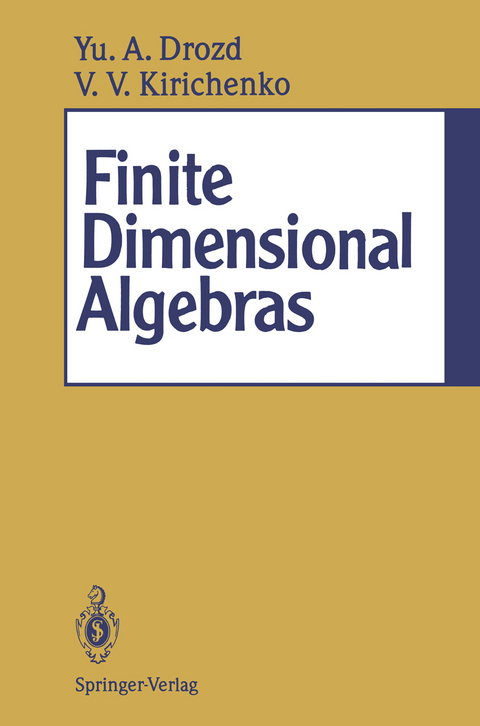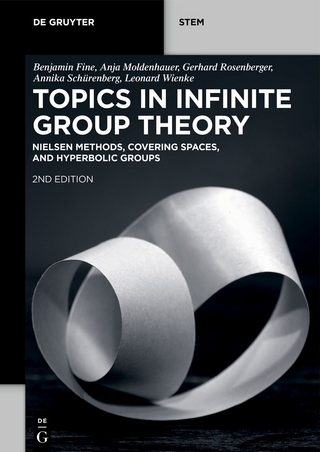
Finite Dimensional Algebras
Springer Berlin (Verlag)
978-3-642-76246-8 (ISBN)
1. Introduction.- 1.1 Basic Concepts. Examples.- 1.2 Isomorphisms and Homomorphisms. Division Algebras.- 1.3 Representations and Modules.- 1.4 Submodules and Factor Modules. Ideals and Quotient Algebras.- 1.5 The Jordan-Hölder Theorem.- 1.6 Direct Sums.- 1.7 Endomorphisms. The Peirce Decomposition.- Exerises to Chapter 1.- 2. Semisimple Algebras.- 2.1 Schur's Lemma.- 2.2 Semisimple Modules and Algebras.- 2.3 Vector Spaces and Matrices.- 2.4 The Wedderburn-Artin Theorem.- 2.5 Uniqueness of the Decomposition.- 2.6 Representations of Semisimple Algebras.- Exercises to Chapter 2.- 3. The Radical.- 3.1 The Radical of a Module and of an Algebra.- 3.2 Lifting of Idempotents. Principal Modules.- 3.3 Projective Modules and Projective Covers.- 3.4 The Krull-Schmidt Theorem.- 3.5 The Radical of an Endomorphism Algebra.- 3.6 Diagram of an Algebra.- 3.7 Hereditary Algebras.- Exercises to Chapter 3.- 4. Central Simple Algebras.- 4.1 Bimodules.- 4.2 Tensor Products.- 4.3 Central Simple Algebras.- 4.4 Fundamental Theorems of the Theory of Division Algebras.- 4.5 Subfields of Division Algebras. Splitting Fields.- 4.6 Brauer Group. The Frobenius Theorem.- Exercises to Chapter 4.- 5. Galois Theory.- 5.1 Elements of Field Theory.- 5.2 Finite Fields. The Wedderburn Theorem.- 5.3 Separable Extensions.- 5.4 Normal Extensions. The Galois Group.- 5.5 The Fundamental Theorem of Galois Theory.- 5.6 Crossed Products.- Exercises to Chapter 5.- 6. Separable Algebras.- 6.1 Bimodules over Separable Algebras.- 6.2 The Wedderburn-Malcev Theorem.- 6.3 Trace, Norm, Discriminant.- Exercises to Chapter 6.- 7. Representations of Finite Groups.- 7.1 Maschke's Theorem.- 7.2 Number and Dimensions of Irreducible Representations.- 7.3 Characters.- 7.4 Algebraic Integers.- 7.5 Tensor Products ofRepresentations.- 7.6 Burnside's Theorem.- Exercises to Chapter 7.- 8. The Morita Theorem.- 8.1 Categories and Functors.- 8.2 Exact Sequences.- 8.3 Tensor Products.- 8.4 The Morita Theorem.- 8.5 Tensor Algebras and Hereditary Algebras.- Exercises to Chapter 8.- 9. Quasi-Frobenius Algebras.- 9.1 Duality. Injective Modules.- 9.2 Lemma on Separation.- 9.3 Quasi-Frobenius Algebras.- 9.4 Uniserial Algebras.- Exercises to Chapter 9.- 10. Serial Algebras.- 10.1 The Nakayama-Skornjakov Theorem.- 10.2 Right Serial Algebras.- 10.3 The Structure of Serial Algebras.- 10.4 Quasi-Frobenius and Hereditary Serial Algebras.- Exercises to Chapter 10.- 11. Elements of Homological Algebra.- 11.1 Complexes and Homology.- 11.2 Resolutions and Derived Functors.- 11.3 Ext and Tor. Extensions.- 11.4 Homological Dimensions.- 11.5 Duality.- 11.6 Almost Split Sequences.- 11.7 Auslander Algebras.- Exercises to Chapter 11.- References.- A.1 Preliminaries. Standard and Costandard Modules.- A.3 Basic Properties.- A.4 Canonical Constructions.- A.6 Final Remarks.- References to the Appendix.
| Erscheint lt. Verlag | 14.12.2011 |
|---|---|
| Mitarbeit |
Anhang von: V. Dlab |
| Übersetzer | V. Dlab |
| Zusatzinfo | XIII, 249 p. |
| Verlagsort | Berlin |
| Sprache | englisch |
| Maße | 155 x 235 mm |
| Gewicht | 410 g |
| Themenwelt | Mathematik / Informatik ► Mathematik ► Geometrie / Topologie |
| Schlagworte | Algebra • Algebras • Algebren (endlichdimensionale) • category theory • Darstellungstheorie • finite group • Galois group • Galois Theory • group theory • Homological algebra • Homologische Algebra • Representation Theory • Vector Space |
| ISBN-10 | 3-642-76246-8 / 3642762468 |
| ISBN-13 | 978-3-642-76246-8 / 9783642762468 |
| Zustand | Neuware |
| Haben Sie eine Frage zum Produkt? |
aus dem Bereich


